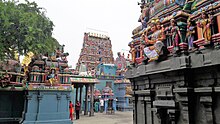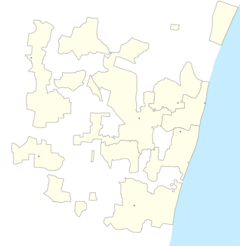
Uthamar Kovil in Uthamarkoil, a village in the outskirts of Tiruchirappalli in the South Indian state of Tamil Nadu, is dedicated to the Hindu Trimurti of Vishnu, Shiva, and Brahma. Constructed in the Dravidian style of architecture, the temple is glorified in the Nalayira Divya Prabandham, the early medieval Tamil canon of the Alvar saints from the 6th–9th centuries CE. It is one of the 108 Divya Desams dedicated to Vishnu, who is worshipped as Purushothaman Perumal and his consort Lakshmi as Poornavalli Thayar.

The Srikalahasti Temple is located in the town of Srikalahasti, in Tirupati district in the state of Andhra Pradesh, India. According to regional tradition, it is said to be the site where Kannappa was ready to offer both his eyes to cover blood flowing from the linga before Shiva stopped him and granted him moksha. The inner temple was constructed around the 5th century and the outer temple was constructed in the 11th century by the Rajendra Chola I and other Chola emperors such as Rajaditya Chola, Rajaraja Chola I, Rajadhiraja Chola I, Kulottunga Chola I, Kulottunga Chola III. Shiva in his aspect as Vayu is worshipped as Kalahasteeswara. The temple is also regarded as Rahu-Ketu kshetra and Dakshina Kailasam.
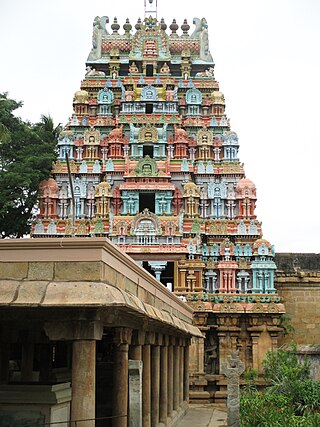
Jambukeswarar Temple, Thiruvanaikaval is a temple of Shiva in Tiruchirapalli district, in the state of Tamil Nadu, India. It is one of the five major Shiva Temples of Tamil Nadu representing the Mahābhūta or five elements; this temple represents the element of water, or neer in Tamil. The sanctum of Jambukeswara has an underground stream.
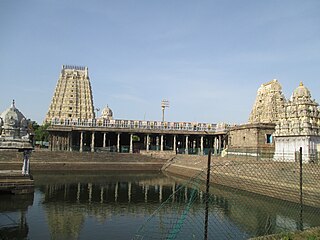
Ekambareswarar Temple is a Hindu temple dedicated to the god Shiva, located in the town of Kanchipuram in Tamil Nadu, India. It is significant to the Hindu sect of Saivism as one of the temples associated with the five elements, the Pancha Bhoota Stalas, and specifically the element of earth, or Prithvi. Shiva is worshiped as Ekambareswarar or Ekambaranathar or Rajlingeswaram, and is represented by the lingam as Prithvi lingam. His consort Parvati is depicted as Elavarkuzhali.

Arunachalesvara Temple is a Hindu temple dedicated to the deity Shiva, located at the base of Arunachala hill in the town of Tiruvannamalai in Tamil Nadu, India. It is significant to the Hindu sect of Shaivism as one of the temples associated with the five elements, the Pancha Bhuta Sthalams, and specifically the element of fire, or Agni.

Kumara Swamy Devasthana, also known as Sri Kumaraswaami Temple, is a Hindu temple located in Hanumanthanagar, in the city of Bangalore, Karnataka, southern India. It is dedicated to the god Kartikeya, also known as Subrahmanya, Kumara Swamy, or Murugan.

Thenupuriswarar Temple is a Hindu temple dedicated to the god Shiva located in the village of Patteeswaram, Tamil Nadu, India. Shiva is worshiped as Thenupuriswarar, and is represented by the lingam. His consort Parvati is depicted as Nyanambikai (Somakamalambigai). The presiding deity is revered in the 7th century Tamil Saiva canonical work, the Tevaram, written by Tamil saint poets known as the Nayanars and classified as Paadal Petra Sthalam. The temple is associated with the legend of Sambandar to whose view Nandi moved to have a direct view of the presiding deity. Muthupandal festival celebrated in the temple in associated with the legend.

Tiruppukkozhiyur is a Hindu temple dedicated to the deity Shiva, located in Avinasi, a panchayat town in Tiruppur district in the South Indian state of Tamil Nadu. Shiva is worshipped as Avinasiappar, and is represented by the lingam. His consort Parvati is depicted as Karunambigai. The presiding deity is revered in the 7th century Tamil Saiva canonical work, the Tevaram, written by Tamil saint poets known as the Nayanars and classified as Paadal Petra Sthalam.

Kandeeswarar Temple is a Hindu temple dedicated to the god Shiva located in Kandiyur also known as Thirukkandiyur or Tirukkandiyur, near Tiruvaiyaru, Tamil Nadu, India. Shiva is worshiped as Kandeeswarar, and is represented by the lingam and his consort Parvati is depicted as Mangalanayagi. The presiding deity is revered in the 7th century Tamil Saiva canonical work, the Tevaram, written by Tamil poet saints known as the nayanars and classified as Paadal Petra Sthalam. As per legends, Shiva is believed to have destroyed eight different demons and the eight Ashta Veeratanam temples are built signifying each of his victories in the war. The temple is one of the eight where Shiva is believed to have removed one of the five heads of Brahma.
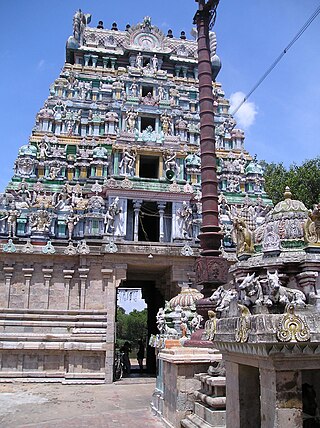
Kalyanasundaresar Temple, Nallur or Thirunallur is a Hindu temple dedicated to the deity Shiva in Nallur, Tamil Nadu, India. It is located 10 km (6.2 mi) away from Kumbakonam, 6 km (3.7 mi) east of Thirukkarugavur, and 30 km (19 mi) south of Thanjavur.

Nadutariappar Temple, Kanrappur is a Hindu temple dedicated to Shiva located at Kanrappur near Tiruvarur, Tamil Nadu, India. The temple is incarnated by the hymns of Appar and is classified as Paadal Petra Sthalam.

Tirunallar Saniswaran Temple or Dharbaranyeswarar Temple is a Hindu temple dedicated to the deity Shiva, located in a village, Thirunallar of karaikal district of Union territory of Puducherry (24 km from Nagapattinam town of Tamil Nadu.
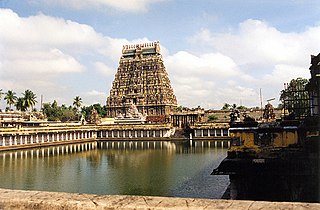
Iconography of Shiva temples in Tamil Nadu is governed by the Shaiva Agamas (IAST:Āgama) that revere the ultimate reality as the Hindu deity, Shiva. Āgama in the Hindu religious context means a traditional doctrine or system which commands faith. Temple worship according to Āgamic rules can be said to have started during the Pallava dynasty in South India, but they were fully under establishment during the Chola dynasty The temples during the Chola period expanded to Sri Lanka and islands in South East Asia. The temple complex was expanding with niches for various deities on the stipulated sides of the sanctum. Lingam was universalised and prakarams (precincts) with subsequent deities came up. The temple parivara expanded considerably during the Chola period. The niches of following Āgamic rules for building Shiva temples in Tamil Nadu, a South Indian state continues even in the modern era. Some of the prime images like that of lingam, Vinayagar and Parvati are present in all the Shiva temples. Almost all the temples follow the same custom during festivals and worship methods with minor exceptions. Most of the Shiva temples in Tamil Nadu and Sri Lanka are built in Dravidian architecture.

Innambur Ezhutharinathar Temple is a Hindu temple dedicated to Shiva, located in Innambur, a village in the outskirts of Kumbakonam, in Thanjavur district in Tamil Nadu, India. Shiva is worshipped as Ezhutharinathar and his consort Parvati as Nithya Kalyani. Ona Kantheeswarar is revered in the 7th century Tamil Saiva canonical work, the Tevaram, written by Tamil saint poets known as the Nayanars and classified as Paadal Petra Sthalam, the 275 temples revered in the canon.

Arthanāreeswarā temple, also known as Thirukodimāda Chenkundrūr, is an ancient Hindu temple, located in Tiruchengode, in the southern Indian state of Tamil Nadu. The temple is dedicated to Arthanāreeswarā, a form of the Hindu deity Shiva combined with his consort Parvati. Also called as "Umayorubāgan" "Mādhorubāgan" and Ammaiyappan (mother-father). The famous Chenkottu Velavar Temple, dedicated to Lord Murugan, is also situated on the same hill and a separate temple for Lord Vinayaka far away from the main temple complex. The Vinayaka temple is situated in a rock on one of the peaks of the Mountain and is called as "Ucchi Pillaiyar Kovil".

Varadaraja Perumal Perundevi Thayar Temple in Puducherry, is dedicated to the Hindu god Vishnu and Hindu goddess Lakshmi. It is located heritage town region of the city. Constructed in the Dravidian style of architecture, the temple is a storehouse of Chola and Pandya architecture.
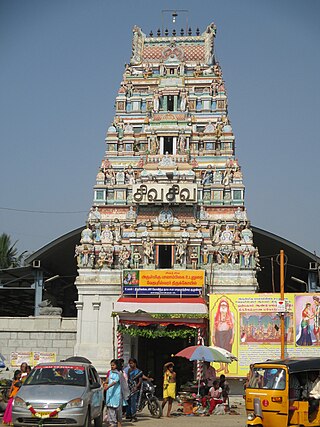
Vedapureeswarar Temple is a Hindu temple dedicated to the deity Shiva, located in Thiruverkadu, a Municipality in Tiruvallur district in the South Indian state of Tamil Nadu. Shiva is worshipped as Vedapureeswarar, and is represented by the lingam. His consort Parvati is depicted as Balambigai. The presiding deity is revered in the 7th century Tamil Saiva canonical work, the Tevaram, written by Tamil saint poets known as the Nayanars and classified as Paadal Petra Sthalam.
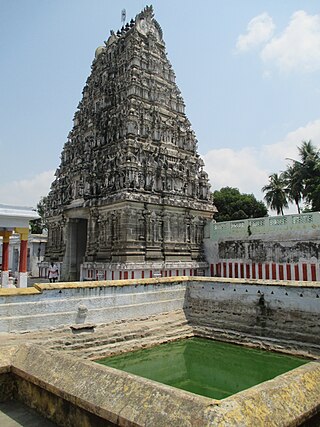
Thirumakaraleeswarar Temple is a Hindu temple dedicated to the deity Shiva, located in Magaral, a village in Kanchipuram district in the South Indian state of Tamil Nadu. Shiva is worshipped as Thirumakaraleeswarar, and is represented by the lingam. His consort Parvati is depicted as Tribuvananayagi. The presiding deity is revered in the 7th-century CE Tamil Saiva canonical work, the Tevaram, written by Tamil saint poets known as the Nayanmars and classified as Paadal Petra Sthalam.

Varadaraja Perumal temple in the South Indian union territory of Puducherry, is dedicated to the Hindu god Vishnu. It is located in Thirubuvanai, a village, located 23 km (14 mi), in the outskirts of Puducherry. Constructed in the Dravidian style of architecture, the temple is a storehouse of Chola architecture and believed to have been built by Parantaka I. The temple has inscriptions from the time of Rajaraja Chola indicating an educational institution operating in the temple.

Veerateeswarar Temple is a Hindu temple located at Vazhuvur in Mayiladuthurai district of Tamil Nadu, India. The presiding deity is Shiva in the form of Veerateswarar and his consort is known as Bala Gujambigai. The village is mentioned in the 7th century Tamil Saiva canonical work, the Tevaram, written by Tamil saint poets known as the nayanars and classified as Vaippu Sthalam, the 276 temples that find mention in it.
